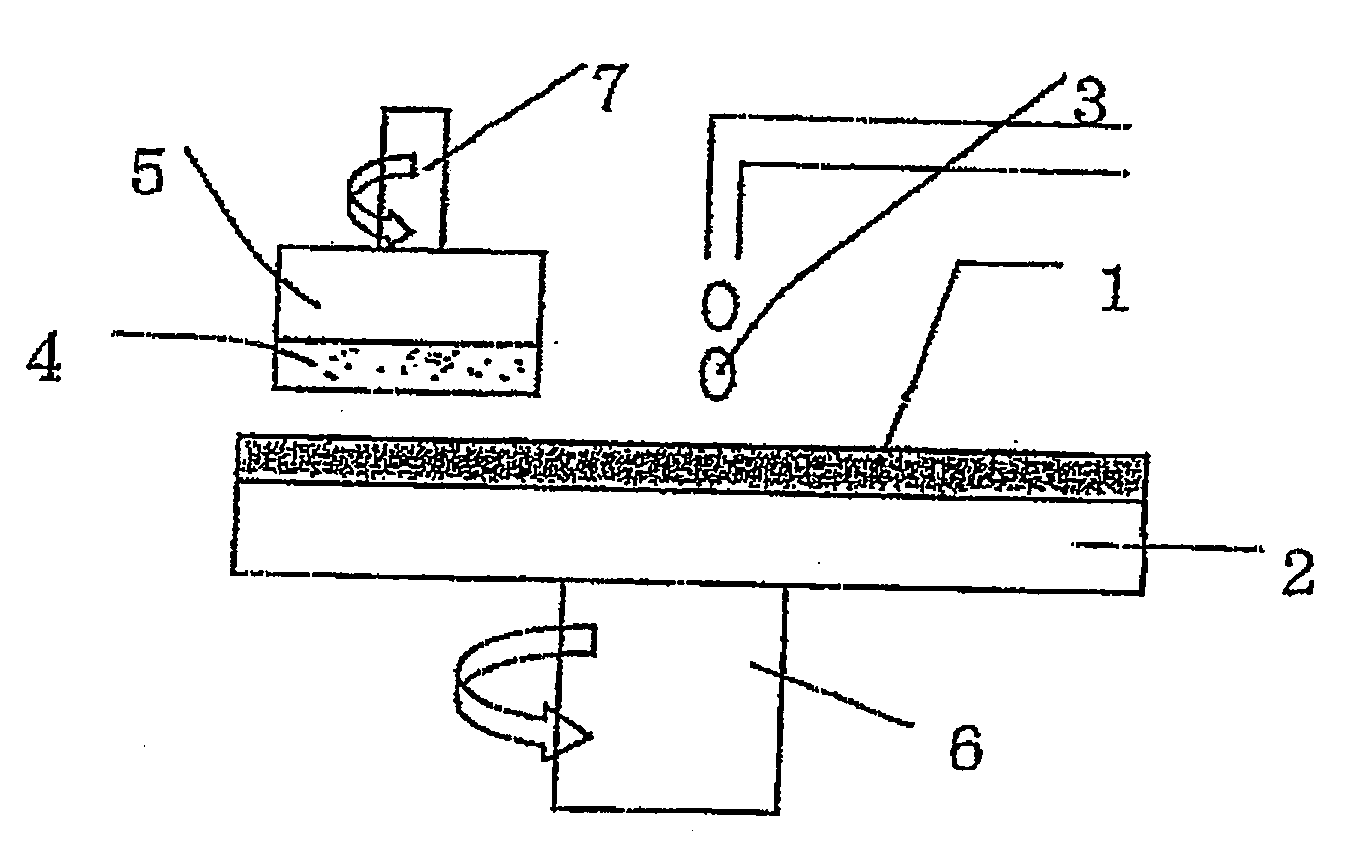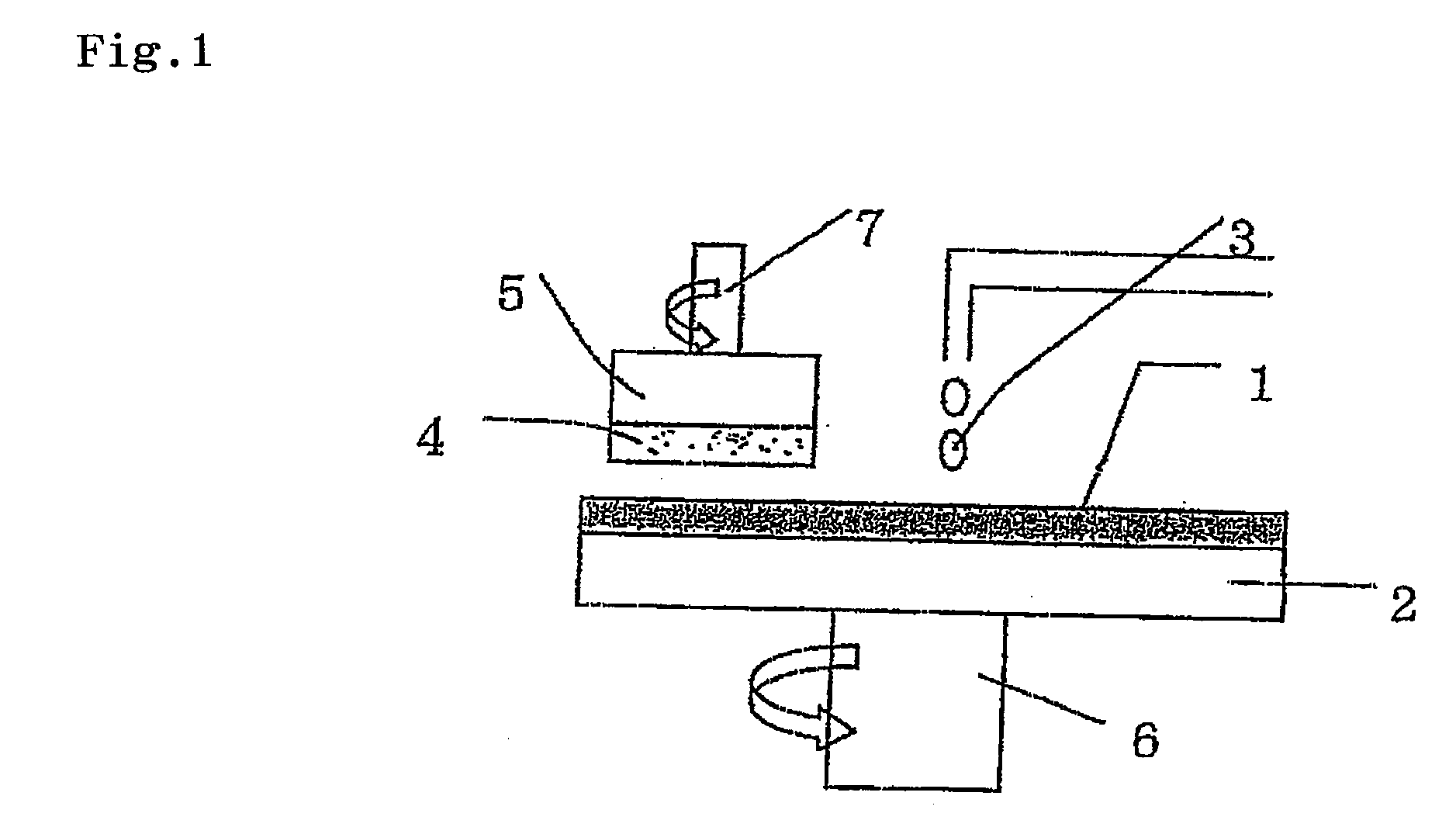Polishing pad
a technology of polishing pad and surface, applied in the field of polishing pad, can solve the problems of not desirable, surface to be polished of polishing object scratching, polishing pad not desirable, etc., and achieve the effects of high polishing rate, excellent planarization property, and hardly generating scratching
- Summary
- Abstract
- Description
- Claims
- Application Information
AI Technical Summary
Benefits of technology
Problems solved by technology
Method used
Image
Examples
example 4
[0168]A reactor was charged with 35 parts by weight of toluene diisocyanate (manufactured by Mitsui Takeda Chemicals, Inc., a mixture of toluene 2,4-diisocyanate / toluene 2,6-diisocyanate=80 / 20), 15.75 parts by weight of 4,4′-dicyclohexylmethane diisocyanate, 44.5 parts by weight of polyester polyol (number average molecular weight 650) obtained by polycondensing adipic acid and diethylene glycol at 150° C., and 4.95 parts by weight of 1,3-butylene glycol (manufactured by Nacalai Tesque, Inc.), and the mixture was heated and stirred at 80° C. for 120 minutes to obtain an isocyanate-terminal prepolymer B (NCO wt %: 11.5 wt %).
[0169]According to the same manner as that of Example 1 except that 100 parts by weight of an isocyanate-terminal prepolymer B was used in place of 100 parts by weight of an isocyanate-terminal prepolymer A in Example 1, a polishing pad was prepared.
Comparative Example 1
[0170]According to the same manner as that of Example 1 except that an amount of a silicone-ba...
example 1
[0176]A reactor was charged with 35 parts by weight of toluene diisocyanate (manufactured by Mitsui Takeda Chemicals, Inc., a mixture of toluene 2,4-diisocyanate / toluene 2,6-diisocyanate=80 / 20), 15.75 parts by weight of 4,4′-dicyclohexylmethane diisocyanate, 44.3 parts by weight of polytetramethylene glycol (manufactured by Mitsubishi Chemical, Co., Ltd., a number average molecular weight 650), and 4.95 parts by weight of 1,3-butylene glycol (manufactured by Nacalai Tesque, Inc.), and the mixture was heated and stirred at 80° C. for 120 minutes to obtain an isocyanate-terminal prepolymer A (NCO wt %: 11.6 wt %).
[0177]Separately, a reactor was charged with 31.9 parts by weight of toluene diisocyanate (manufactured by Mitsui Takeda Chemicals, Inc., a mixture of toluene 2,4-diisocyanate / toluene 2,6-diisocyanate=80 / 20), 8.5 parts by weight of 4,4′-dicyclohexylmethane diisocyanate, 53.9 parts by weight of polytetramethylene glycol (manufactured by Mitsubishi Chemical Co., Ltd., a number ...
example 2
[0179]According to the same manner as that of Example 1 except that 23 parts by weight of Ethacure 300 (manufactured by Albemarle Corporation, a mixture of 3,5-bis(methylthio)-2,6-toluene diamine and 3,5-bis(methylthio)-2,4-toluenediamine) was used in place of 29 parts by weight of 4,4′-methylenebis(o-chloroaniline) in Example 1, a polishing pad was prepared.
PUM
| Property | Measurement | Unit |
|---|---|---|
| Fraction | aaaaa | aaaaa |
| Fraction | aaaaa | aaaaa |
| Fraction | aaaaa | aaaaa |
Abstract
Description
Claims
Application Information
 Login to View More
Login to View More - R&D
- Intellectual Property
- Life Sciences
- Materials
- Tech Scout
- Unparalleled Data Quality
- Higher Quality Content
- 60% Fewer Hallucinations
Browse by: Latest US Patents, China's latest patents, Technical Efficacy Thesaurus, Application Domain, Technology Topic, Popular Technical Reports.
© 2025 PatSnap. All rights reserved.Legal|Privacy policy|Modern Slavery Act Transparency Statement|Sitemap|About US| Contact US: help@patsnap.com


